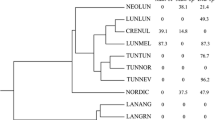Abstract
Morphological, cytological, and paper Chromatographic studies of populations from northern Michigan and examination of herbarium specimens from throughout North America were used to clarify the relationships ofGoodyera oblongifolia, G. repens var.ophioides, andG. tesselata. A canonical analysis of morphological data from mixed populations of these three species depictsG. tesselata as intermediate betweenG. oblongifolia andG. repens var.ophioides. The latter two species are diploid (2n = 30) andG. tesselata is tetraploid (2n = 60). Triploids (2n = ca. 45) were found in two mixed-species populations in northern Michigan.Goodyera tesselata produces three phenolic compounds present inG. oblongifolia and five different compounds present inG. repens var.ophioides. The range ofG. tesselata is confined to glaciated territory (except for two stations) in northeastern North America where the postglacially produced ranges ofG. oblongifolia andG. repens var.ophioides overlap. However,G. tesselata is quite abundant in areas outside the region of sympatry of the other two species. Based on this evidence, it is postulated thatG. tesselata is an allotetraploid species which resulted from hybridization betweenG. oblongifolia andG. repens var.ophioides during early post-Pleistocene. The slightly earlier blooming season ofG. tesselata may have been selected for to provide a measure of reproductive isolation between the tetraploid and its parents and to adapt the new species to the rather short growing season of northeastern North America.
Similar content being viewed by others
Literature Cited
Ackerman, J. D. 1975. Reproductive biology ofGoodyera oblongifolia (Orchidaceae). Madroño23: 191–198.
Britton, N. L. &A. Brown 1896. An Illustrated flora of the northern United States, Canada, and the British Possessions.1: 474–475. Scribners, New York.
Case, F. W. 1964. Orchids of the western Great Lakes region. Cranbrook Institute of Science, Bloomfield Hills, Mich.
Constance, L. &R. H. Shan 1948. The genusOsmorhiza (Umbelliferae). A study in geographic affinities. Univ. Calif. Publ. Bot.23: 111–156.
Darwin, C. 1886. On the fertilisation of orchids by insects. 2nd ed. Appleton & Co., New York.
Fassett, N. C. 1935. A study ofStreptopus. Rhodora37: 88–113.
Fassett, N. C. 1941. Mass collections:Rubus odoratus andR. parviflorus. Ann. Missouri Bot. Gard.28: 299–374.
Fassett, N. C. 1945.Juniperus virginiana, J. horizontalis, andJ. scopulorum. IV. Hybrid swarms ofJ. virginiana andJ. horizontalis. Bull. Torrey Bot. Club72: 379–384.
Fernald, M. L. 1899. The rattlesnake plantains of New England. Rhodora1: 2–7.
Fernald, M. L. 1935. Critical plants of the upper Great Lakes region of Ontario and Michigan. Rhodora37: 197–222.
Fuller, A. M. 1933. Studies on the flora of Wisconsin. Part 1: The orchids; Orchidaceae. Bull. Public Museum Milwaukee14: 1–284.
Hagerup, O. 1952. Bud autogamy in some northern orchids. Phytomorphology2: 51–60.
Heslop-Harrison, J. 1953. Microsporogenesis in some triploid dactylorchid hybrids. Ann. Bot. (London) n. s.17: 539–549.
Hultén, E. 1927. Flora of Kamchatka and the adjacent islands. Stockholm.
- 1937. Outline of the history of arctic and boreal Biota during the Quaternary Period. Stockholm.
- 1962. The Circumpolar Plants. I. Stockholm.
Iltis, H. H. 1965. The genusGentianopsis (Gentianaceae): Transfers and phytogeographic comments. Sida2: 129–154.
Kane, J. M. 1966. Biosystematics of the genusActaea in North America (Ranunculaceae). Amer. J. Bot.53: 634. (Abstr.)
Kliphius, E. 1963. Cytological observations in relation to taxonomy of the orchids of the Netherlands. Acta Bot. Neerl.12: 172–194.
Kowal, R. R., M. J. Lechowicz & M. J. Adams 1975. The use of canonical analysis to compare response curves in physiological ecology. Flora. (in press).
Levin, D. A. 1967. An analysis of hybridization inLiatris. Brittonia19: 248–260.
Liu, T. S. &H. J. Su 1973. New additions to the orchidaceous flora of Taiwan, China. II. Quart. J. Taiwan Mus.26: 443–447.
Loddiges, C. 1824. Bot. Cab.10: t. 952.
Löve, A. 1954. Cytotaxonomical evaluation of corresponding taxa. Vegetatio5/3-6: 212–224.
Löve, A. &W. Simon 1968. Cytotaxonomical notes on some American orchids. Southw. Naturalist13: 335–342.
Löve, D. &H. Harries 1963.Streptopus oreopolus Fern., a hybrid taxon. Rhodora65: 310–317.
Mabry, T. J., K. Markham &M. Thomas 1970. The systematic identification of flavonoids. Springer-Verlag, New York.
Marcks, B. G. 1974. Preliminary reports on the flora of Wisconsin No. 66. Cyperaceae II-Sedge Family II. The genus Cyperus—The umbrella sedges. Trans. Wisconsin Acad. Sci.62: 261–284.
Medlar, J. T. & D. W. Carney 1963. Bumblebees of Wisconsin. Wisconsin Agric. Exp. Sta. Res. Bull. 240.
Mehra, P. N. &K. S. Bawa 1970. Cytological observations on some northwest Himalayan orchids. Caryologia23: 273–282.
Mehra, P. N. &K. S. Bawa &S. P. Vij 1974. Some observations on the ecological adaptations and distribution pattern of the East Himalayan orchids. Amer. Orchid Soc. Bull.43: 301–315.
Milliron, H. E. 1939. The taxonomy and distribution of Michigan Bombidae, with keys. Pap. Michigan Acad. Sci.24: 167–182.
Müller, H. 1883. The fertilization of flowers. Trans. by D. W. Thomson. MacMillan & Co., London.
Nakai, T. 1953. Opera phytologica novissima. Bull. Natl. Sci. Mus.33: 1–30.
Richardson, M. M. 1934. The chromosomes of some British orchids. Proc. Durham Univ. Phil. Soc.9: 135–140.
Schofield, W. B. 1969. Phytogeography of northwestern North America: bryophytes and vascular plants. Madrono20: 155–207.
Seal, H. L. 1964. Multivariate statistical analysis for biologists. Methuen, London.
Tanaka, R. 1965. Chromosome numbers of some species of Orchidaceae from Japan and its neighboring areas. J. Jap. Bot.40: 65–77.
Taylor, R. L. & G. A. Mulligan 1968. Flora of the Queen Charlotte Islands. Part 2. Cytological aspects of the vascular plants. Canad. Dept. Agric. Res. Branch. Monograph No. 4, part 2.
Watson, S. &J. M. Coulter 1889. Gray’s manual of the botany of the northern United States (6th ed.). American Book Co., New York.
Author information
Authors and Affiliations
Additional information
Based on a thesis submitted for the M.S. degree at the University of Wisconsin, Madison, Wisconsin.
Rights and permissions
About this article
Cite this article
Kallunki, J.A. Population studies in Goodyera (Orchidaceae) with emphasis on the hybrid origin of G. Tesselata. Brittonia 28, 53–75 (1976). https://doi.org/10.2307/2805559
Issue Date:
DOI: https://doi.org/10.2307/2805559




